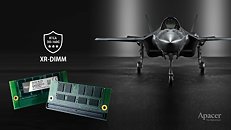Friday, August 23rd 2019

Apacer Unveils its First XR-DIMM DRAM Module with RTCA DO-160G Certification
Apacer, the leading manufacturer of industrial-grade memory, announces the release of the XR-DIMM. This rugged memory module is the first on the market to meet the exacting standards of the US RTCA DO-160G test, an aviation equipment certification that marks the XR-DIMM as resistant to high levels of vibration and therefore ideal for defense and aeronautical applications.
Since 2018, Apacer has been manufacturing DDR4 XR-DIMM modules with rugged stability in mind. Though previous models have been compliant with MIL-STD-810G, this new module is the first to be proven compliant with the US RTCA DO-160G standard, making it the ideal choice for manufacturers who need reliable operation through extreme vibration and shock.Many defense, rail transit and in-vehicle systems worldwide still rely on standard memory modules. However, forward-looking manufacturers know Apacer's XR-DIMM modules offer significant improvements on reliability, with additions including 300-pin connectors and mounting holes to keep components in place. This allows the XR-DIMM to remain steady even when vehicles encounter uneven roads, powerful winds, or violent waves and to deliver stable performance.
As a well-established manufacturer in Taiwan, Apacer benefits from access to a booming aviation industry. According to Taiwan's Ministry of Economic Affairs, the total output value of Taiwan's aviation industry grew 11% in 2018 to almost US$4 billion. The 2019 Taipei International Aerospace and Defense Industry Exhibition also reported a record number of exhibitors and booths this year. Aerospace and defense manufacturers from Taiwan and from the rest of the world look to Apacer to create cutting-edge DRAM modules and SSDs. The XR-DIMM module with RTCA DO-160G certification is just the latest in a long line of Apacer innovations in this field. For more information, visit this page.
Since 2018, Apacer has been manufacturing DDR4 XR-DIMM modules with rugged stability in mind. Though previous models have been compliant with MIL-STD-810G, this new module is the first to be proven compliant with the US RTCA DO-160G standard, making it the ideal choice for manufacturers who need reliable operation through extreme vibration and shock.Many defense, rail transit and in-vehicle systems worldwide still rely on standard memory modules. However, forward-looking manufacturers know Apacer's XR-DIMM modules offer significant improvements on reliability, with additions including 300-pin connectors and mounting holes to keep components in place. This allows the XR-DIMM to remain steady even when vehicles encounter uneven roads, powerful winds, or violent waves and to deliver stable performance.
As a well-established manufacturer in Taiwan, Apacer benefits from access to a booming aviation industry. According to Taiwan's Ministry of Economic Affairs, the total output value of Taiwan's aviation industry grew 11% in 2018 to almost US$4 billion. The 2019 Taipei International Aerospace and Defense Industry Exhibition also reported a record number of exhibitors and booths this year. Aerospace and defense manufacturers from Taiwan and from the rest of the world look to Apacer to create cutting-edge DRAM modules and SSDs. The XR-DIMM module with RTCA DO-160G certification is just the latest in a long line of Apacer innovations in this field. For more information, visit this page.

10 Comments on Apacer Unveils its First XR-DIMM DRAM Module with RTCA DO-160G Certification
Or what if that RAM fails for whatever reason and needs replacing ?
No, soldered is not a good idea anywhere, it basically requires replacing an entire computer for just one component that is insufficient or failed.
And those computers are usually extremely difficult to disassemble, as they are deeply embedded into the machine (airplane, car, etc.)
So much simpler just to open the service panel and replace the memory, or CPU, or whatever needs replacing...
For automotive/marine? For some least critical entertainment devices, could be...
Defence is almost always a step behind, and for good reason. Sure, COTS-based projects for things like logistics vehicles or a cost-effective missile or drone program are in vogue as of late and always nice to keep costs down, and those might involve mass-market computing (a few generations out of date, no less), but you'll never see those components touch the core systems most crucial to the functioning of a Navy surface combatant, for example.
Could see this have a place in rail, but again, are any of these industries forgoing reliability in favour of upgradeability?
Modern vehicles are connected to the internetz.... for example some DB (Deutsche Bahn) coaches have small LCD displays above the seats that show if one is reserved, initials of the person that reserved it and until what station. Removes the confusion of "is this seat taken?".
In the Netherlands, buses have computers that are GPS enabled and show your current location, what are the next stations, and an ETA until you need to get off the bus. Very handy especially if it's not your common route.
For all these companies, the contrary, anything that can help them save costs and reduce the downtime due to computer malfunctions.
Having to replace the entire damn computer (which is probably difficult to access) just because one RAM chip failed can get very costly.
Upgrade in a few ways and a real downgrade in most...
LoL